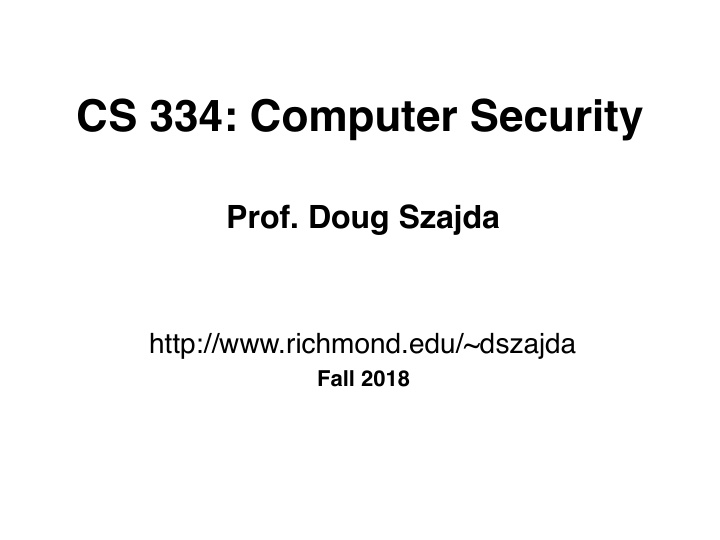



CS 334: Computer Security Prof. Doug Szajda http://www.richmond.edu/~dszajda Fall 2018
What Is This Class? • Computer security = how to keep computing systems functioning as intended & free of abuse … – … and keep data we care about accessed only as desired … – … in the presence of an adversary • We will look at: – Attacks and defenses for • Programs • Networks • Systems (OS, Web) – Securing data and communications – Enabling/thwarting privacy and anonymity • How these notions have played out in the Real World • Issues span a very large range of CS – Programming, systems, hardware, networking, theory
What Will You Learn? • How to think adversarially • How to assess threats for their significance • How to build programs & systems that have robust security properties • How to gauge the protections and limitations provided by today’s technology – How to balance the costs of security mechanisms vs. the benefits they offer • How today’s attacks work in practice • How security issues have played out “for real” (case studies)
Ethics & Legality • We will be discussing (and launching!) attacks - many quite nasty - and powerful eavesdropping technology • None of this is in any way an invitation to undertake these in any fashion other than with informed consent of all involved parties – The existence of a security hole is no excuse • These concerns regard not only ethics but UR policy and Virginia/United States law • If in some context there’s any question in your mind, come talk with me first
Course Overview • Software issues – exploits, defenses, design principles • Web security – browsers, servers, authentication • Networking – protocols, imposing control, denial-of-service • Large-scale automated attacks – worms & botnets • Securing communication & data via cryptography – confidentiality, integrity, signatures, keys, e-cash
Course Overview, con’t • Operating systems –access control, isolation, virtual machines, viruses & rootkits • The pervasive problem of Usability • Privacy – anonymity, releasing data, remanence • Detecting/blocking attacks in “real time” • Landscape of modern attacks – spam, phishing, underground economy • Case studies
Some Broad Perspectives • A vital, easily overlooked facet of security is policy (and accompanying it: operating within constraints ) • High-level goal is risk management, not bulletproof protection. – Much of the effort concerns “raising the bar” and trading off resources • How to prudently spend your time & money? • Key notion of threat model: what you are defending against – This can differ from what you’d expect – Consider the Department of Energy …
Modern Threats • An energetic arms race between attackers and defenders fuels rapid innovation in “malcode” … • … including powerful automated tools … • … and defenders likewise devise novel tactics …
13
14
Modern Threats • An energetic arms race between attackers and defenders fuels rapid innovation in “malcode” … • … including powerful automated tools … • … and defenders likewise devise novel tactics …
Modern Threats • An energetic arms race between attackers and defenders fuels rapid innovation in “malcode” … • … including powerful automated tools … • … and defenders likewise devise novel tactics …
Modern Threats, con’t • Most cyber attacks aim for profit and are facilitated by a well-developed “underground economy … • … but recent times have seen the rise of nation-state issues, including: – Censorship / network control – Espionage – … and war
24
25
Modern Threats, con’t • Most cyber attacks aim for profit and are facilitated by a well-developed “underground economy … • … there are also extensive threats to privacy including identity theft • … but recent times have seen the rise of nation-state issues, including: – Censorship / network control – Espionage – … and war
28
29
Modern Threats, con’t • Most cyber attacks aim for profit and are facilitated by a well-developed “underground economy … • … there are also extensive threats to privacy including identity theft • … and recent times have seen the rise of nation-state issues, including: – Censorship / network control – Espionage – … and war
Source: http://www.usatoday.com/story/news/world/2014/02/05/top-ten-internet-censors/5222385/ 32
33
34
35
36
37
Modern Threats, con’t • Most cyber attacks aim for profit and are facilitated by a well-developed “underground economy … • … there are also extensive threats to privacy including identity theft • … and recent times have seen the rise of nation-state issues, including: – Censorship / network control – Espionage – … and war
41
(August 19, 2014) 42
Modern Threats, con’t • Most cyber attacks aim for profit and are facilitated by a well-developed “underground economy … • … there are also extensive threats to privacy including identity theft • … but recent times have seen the rise of nation-state issues, including: – Censorship / network control – Espionage – … and war
46
Recommend
More recommend